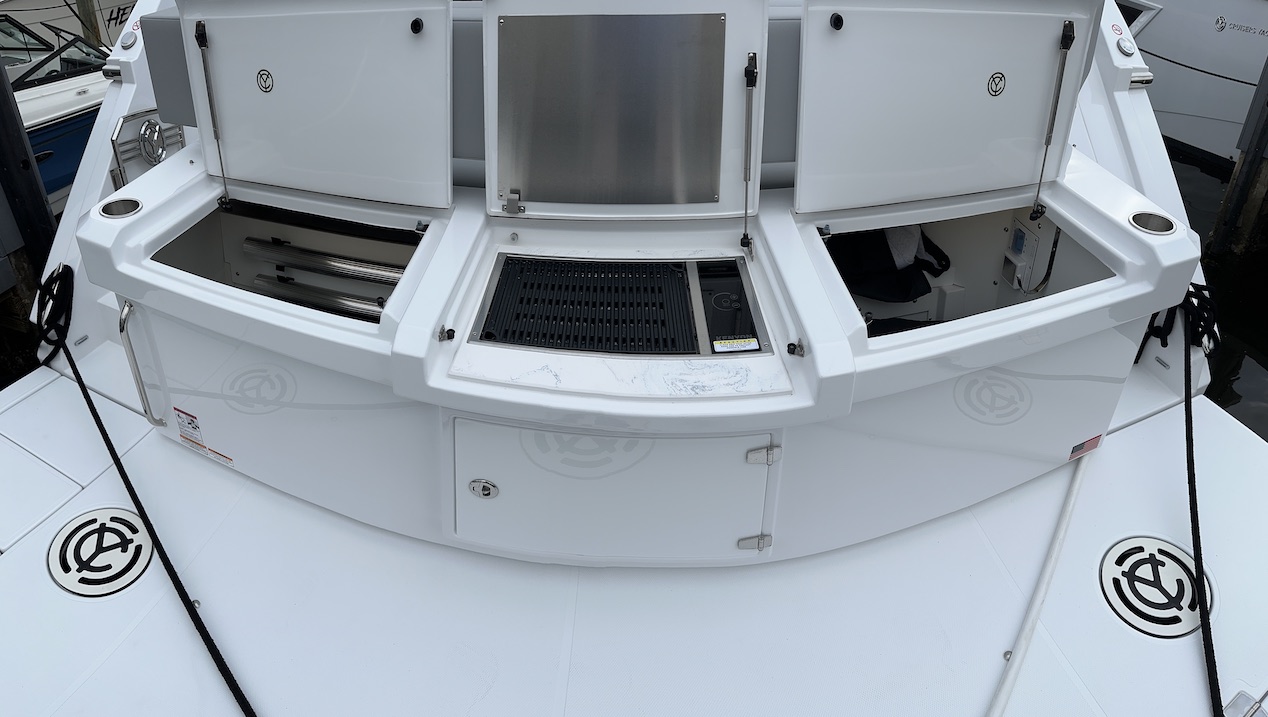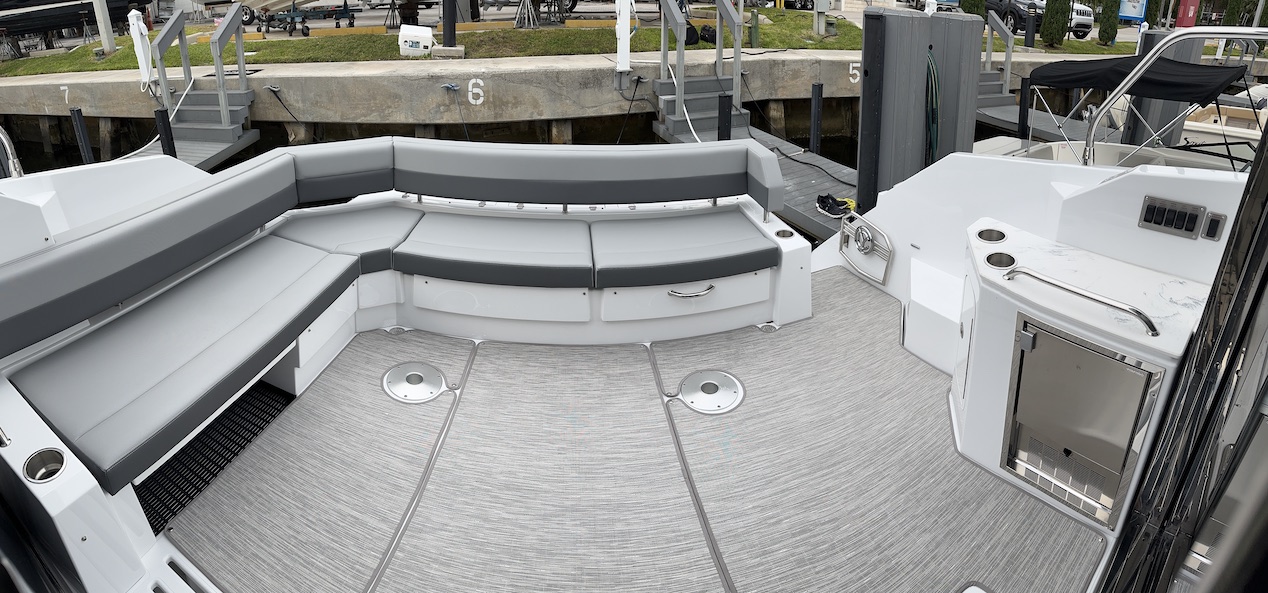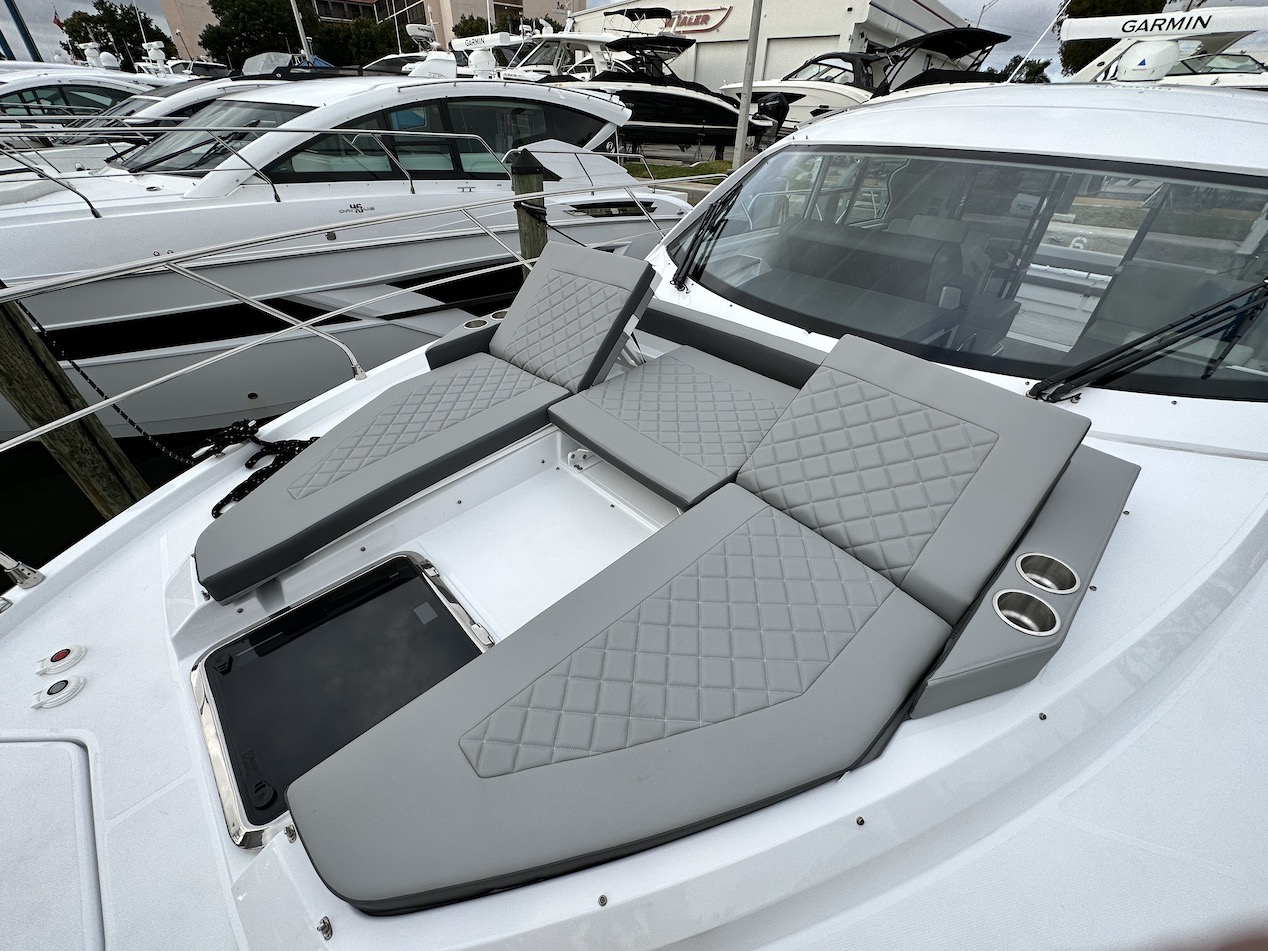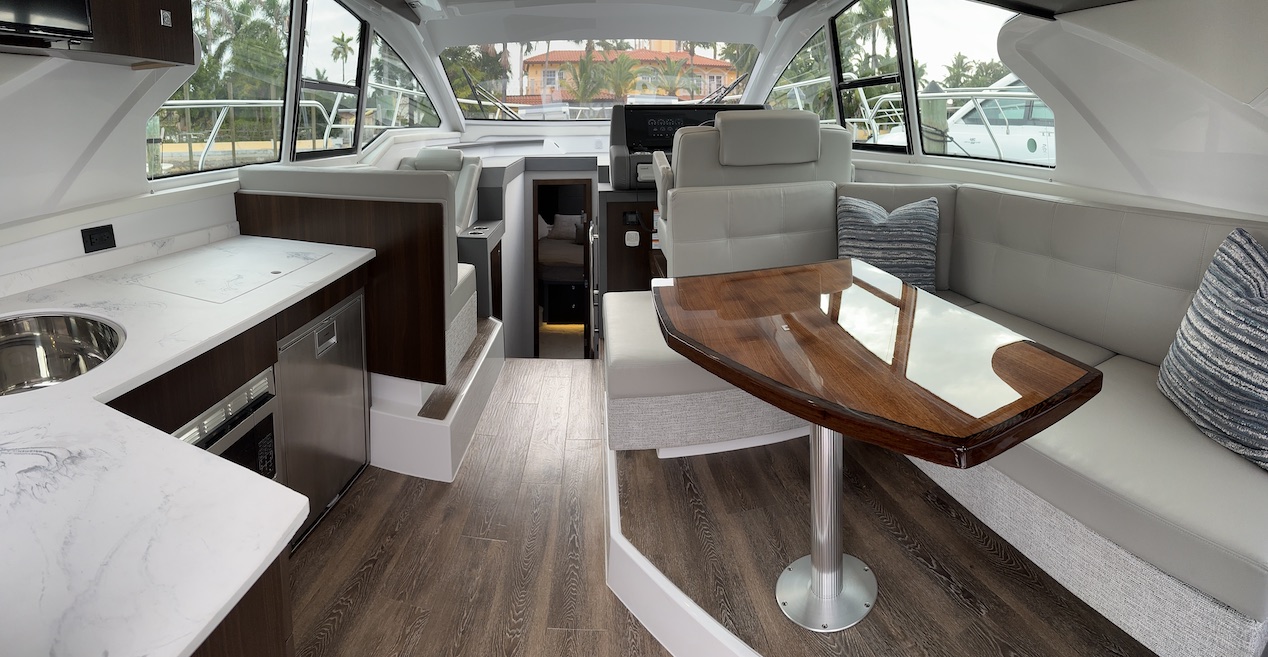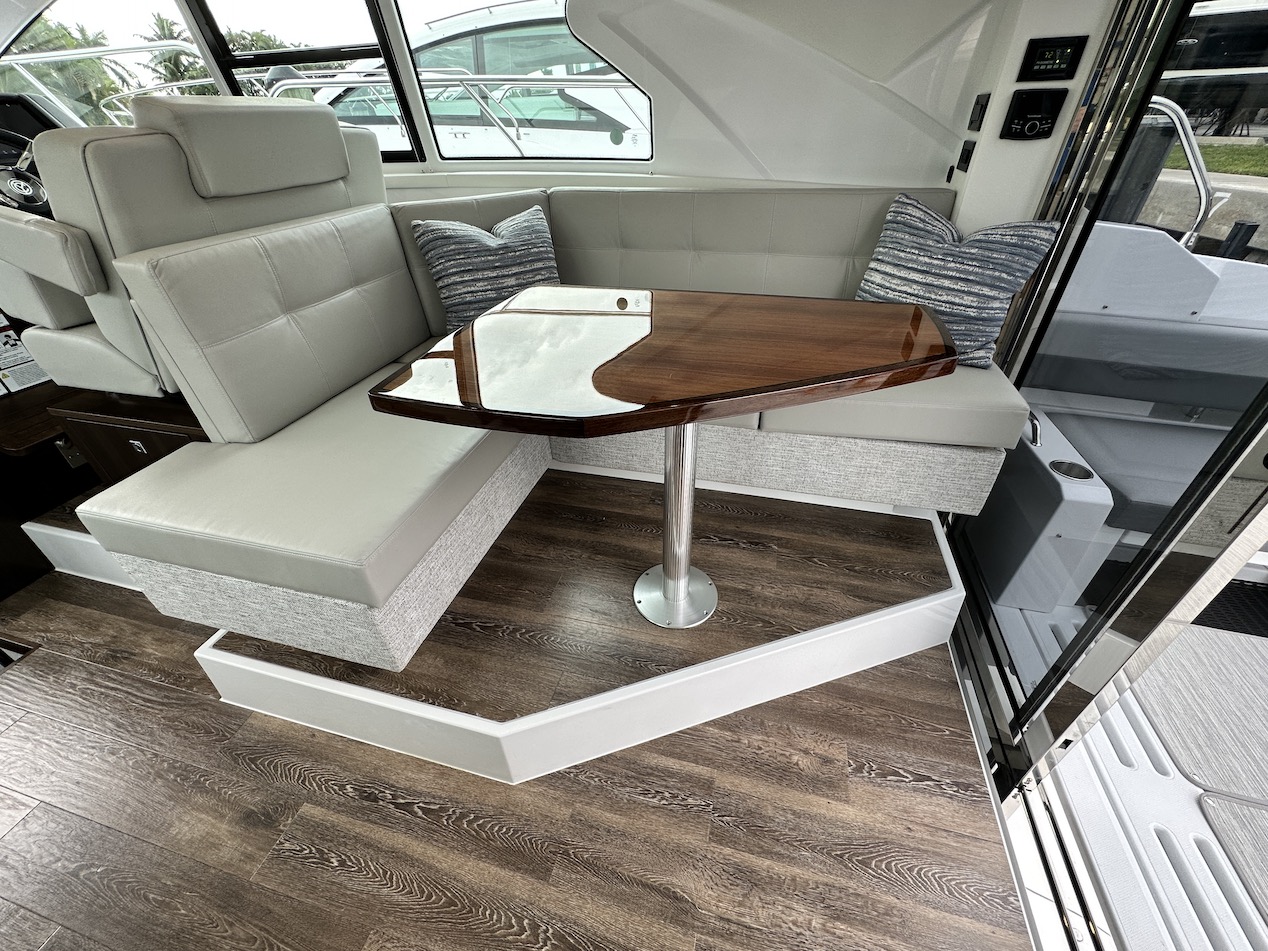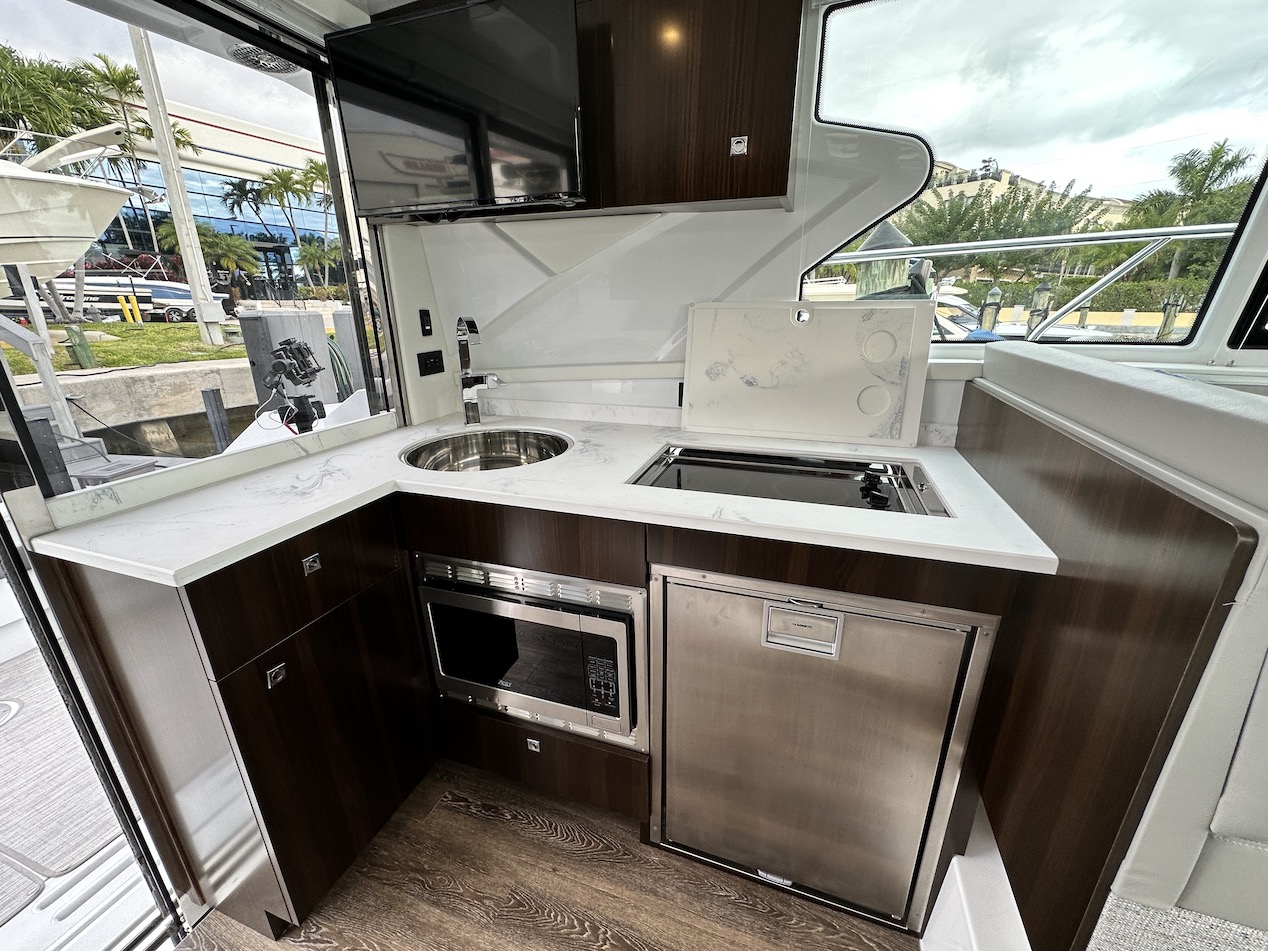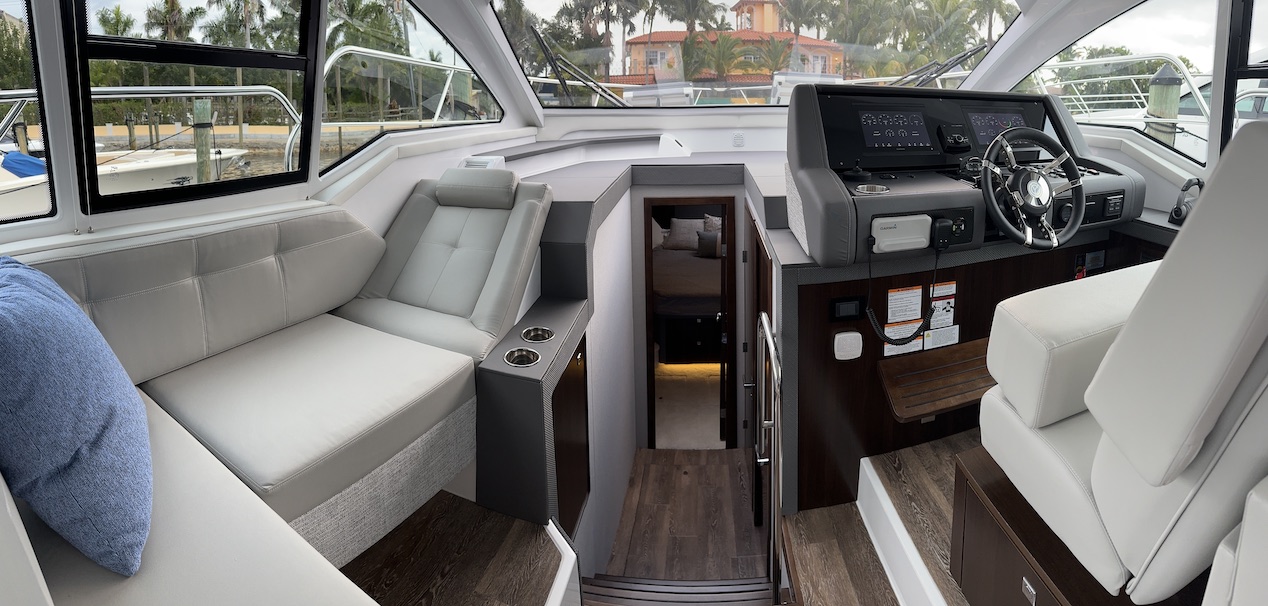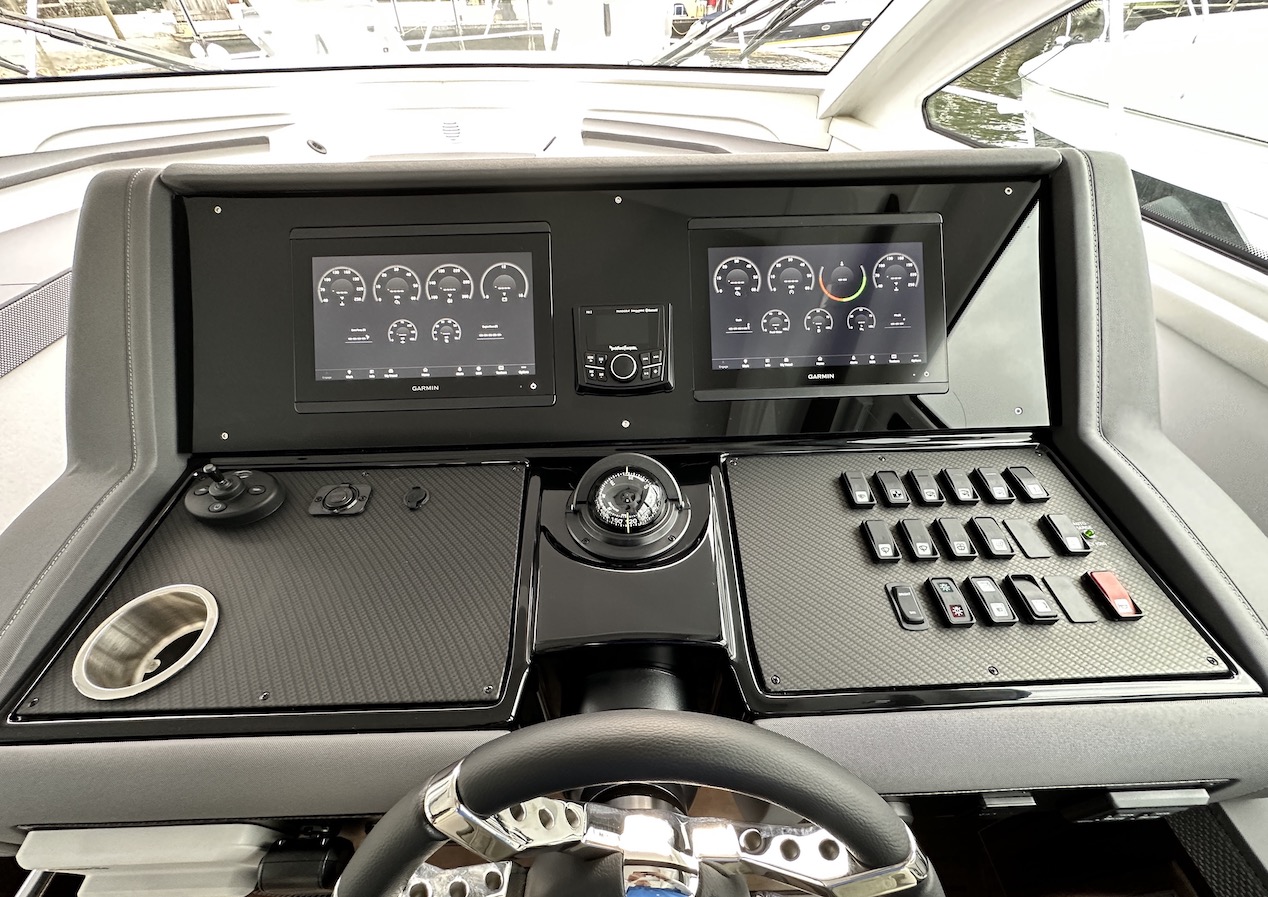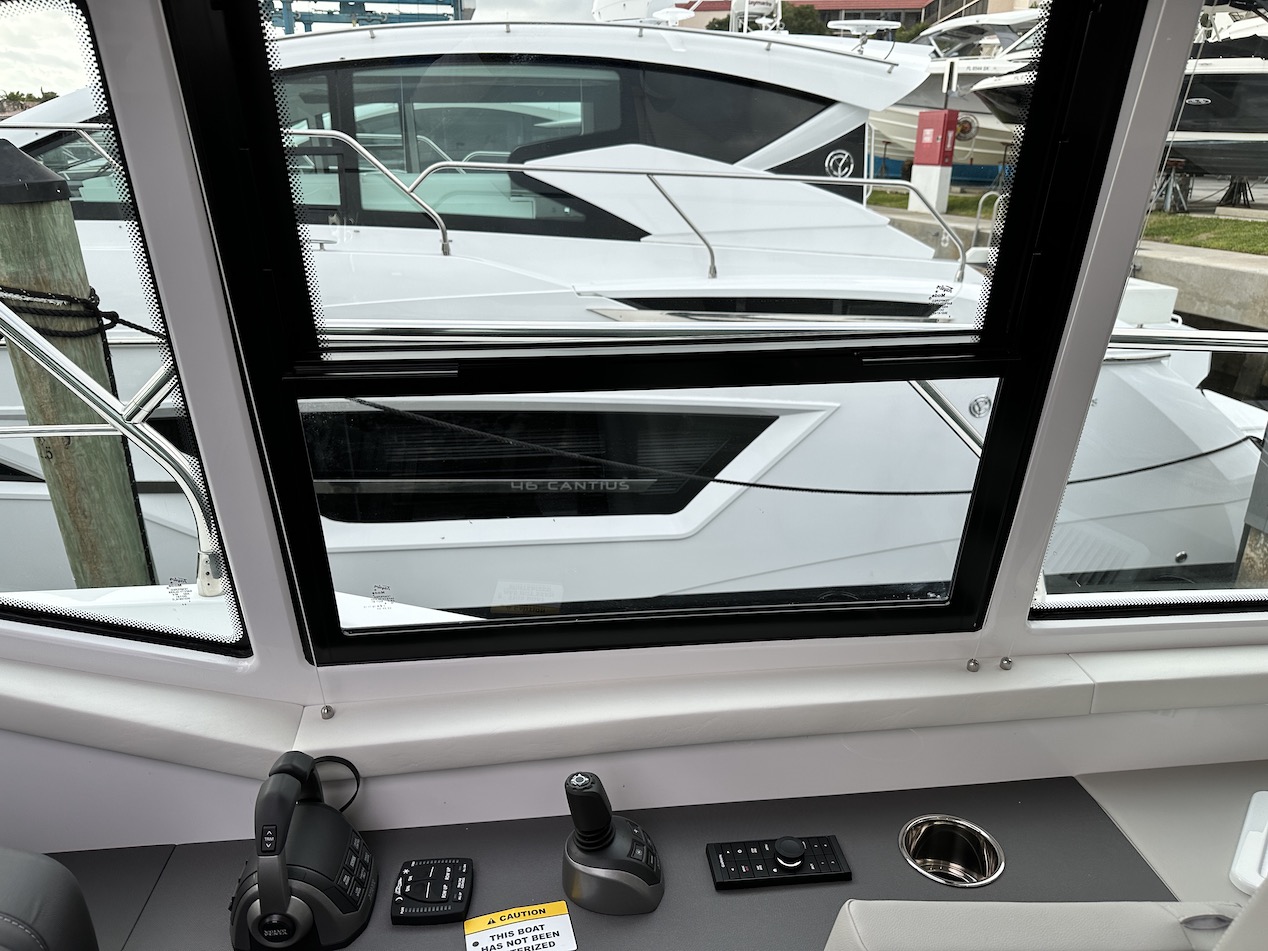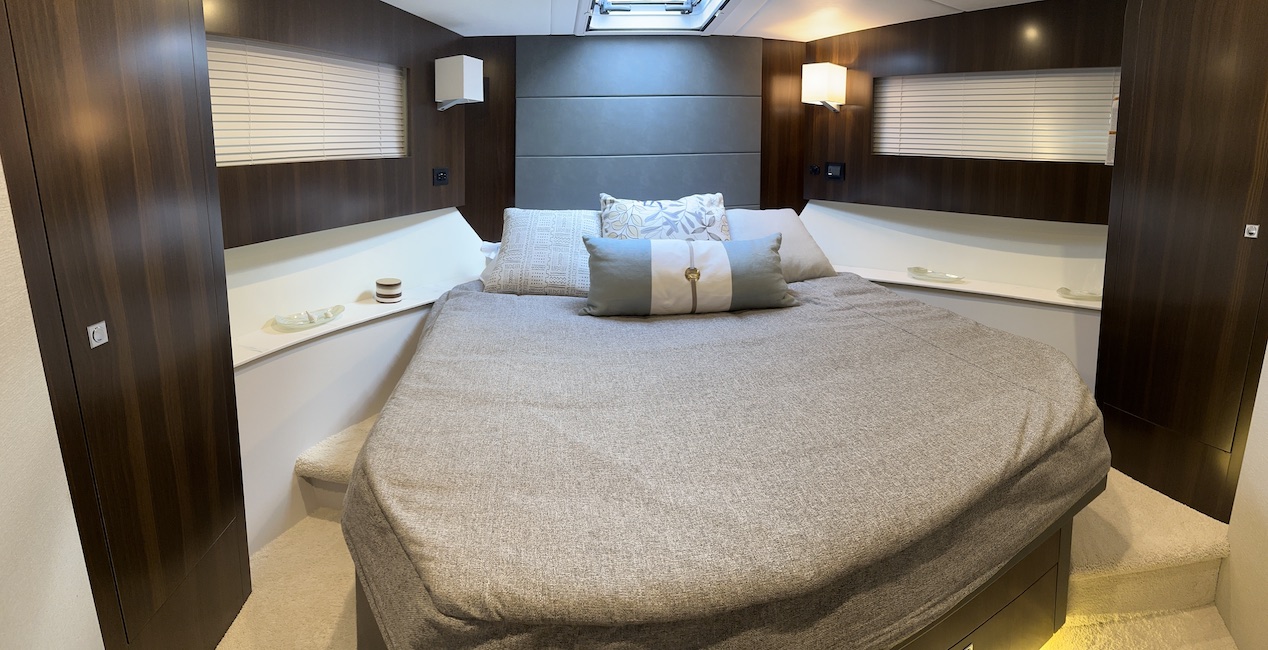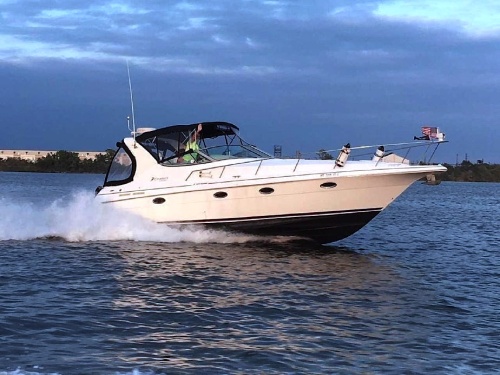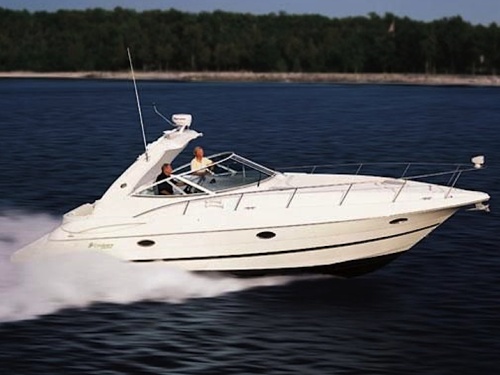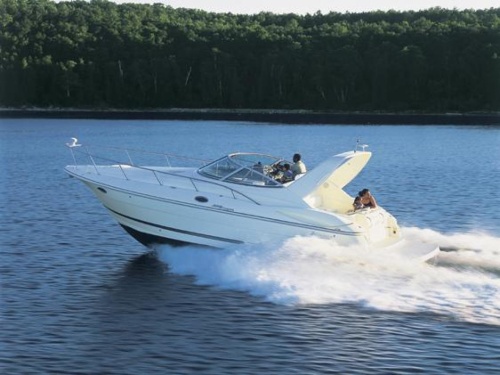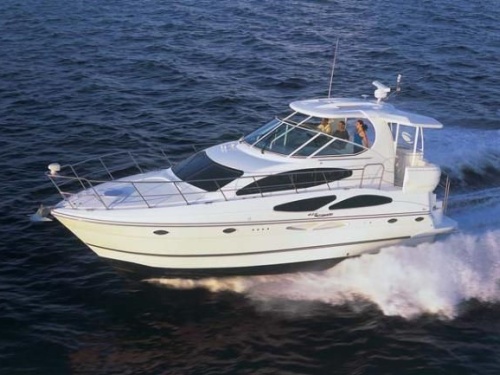Access More Boat Tests
Already have an account? Login
Cruisers Yachts 42 Cantius (2023-)
2 x 370-hp Volvo Penta IPS500
Brief Summary
When Cruisers Yachts introduced the 42 Cantius, it started out 12 yrs. ago as an evolution of its retired 41 Cantius. While the company seems to have learned a thing or two from that legacy model in designing its new boat, the 42 stands in no one’s shadow.
Key Features
- Transom bar with large utility storage
- Cockpit L-shaped seating
- Standard 48 quart cooler in cockpit
- One standard cockpit table
- Multi-directional sliding patio door
- Foredeck chaise lounge
- Aft galley layout
- Large L-shaped dinette with storage
- Doublewide adjustable helm seat with bolsters
- Two stateroom layout
Test Results
| RPM | MPH | Knots | GPH | MPG | NMPG | STAT. MILE | NM | dBa |
|---|---|---|---|---|---|---|---|---|
| 600 | 4.5 | 3.9 | 0.6 | 8.1 | 7 | 2185 | 1899.6 | 58 |
| 1000 | 6.9 | 6 | 2 | 3.5 | 3 | 932 | 810 | 62 |
| 1250 | 8.2 | 7.1 | 3.3 | 2.5 | 2.2 | 677 | 588.8 | 65 |
| 1500 | 9.3 | 8.1 | 5 | 1.9 | 1.6 | 502 | 436.7 | 67 |
| 1750 | 10.3 | 8.9 | 8.2 | 1.3 | 1.1 | 338 | 293.5 | 73 |
| 2000 | 11.1 | 9.7 | 11.5 | 1 | 0.8 | 261 | 226.6 | 74 |
| 2200 | 11.8 | 10.2 | 15 | 0.8 | 0.7 | 212 | 183.9 | 75 |
| 2400 | 13.5 | 11.7 | 18.5 | 0.7 | 0.6 | 197 | 171.3 | 76 |
| 2600 | 15.9 | 13.8 | 22 | 0.7 | 0.6 | 195 | 169.7 | 77 |
| 2800 | 19.1 | 16.6 | 25.5 | 0.7 | 0.6 | 202 | 175.4 | 77 |
| 3000 | 23.4 | 20.3 | 28 | 0.8 | 0.7 | 226 | 196.2 | 78 |
| 3200 | 27.5 | 23.9 | 31.5 | 0.9 | 0.8 | 236 | 205 | 78 |
| 3400 | 30.7 | 26.7 | 33.5 | 0.9 | 0.8 | 247 | 214.8 | 77 |
| 3620 | 34 | 29.5 | 41 | 0.8 | 0.7 | 224 | 194.4 | 78 |
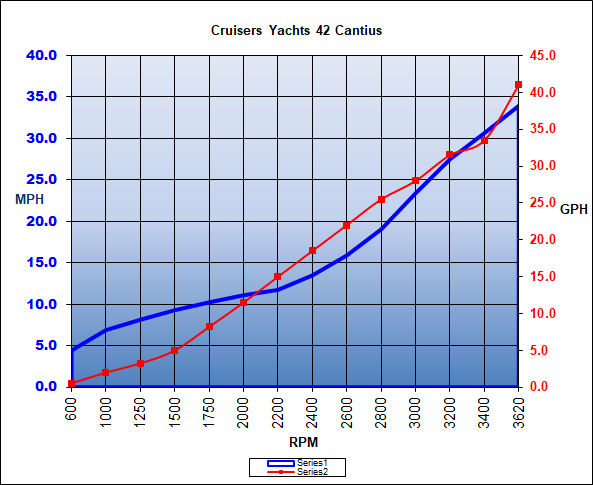
Specifications
| Length Overall |
43' 2" 13.15 m |
|---|---|
| Beam |
13' 8" 4.16 m |
| Dry Weight |
28,469 lbs. 12,913 kg |
| Tested Weight |
29,537 lbs. 13,398 kg |
| Draft |
40" 1.01 m |
| Bridge Clearance |
13' 8" 4.16 m |
| Fuel Capacity |
300 gal. 1,136 L |
| Water Capacity |
80 gal. 303 L |
| Total Weight |
29,537 lbs. 13,398 kg |
Acceleration Times & Conditions
| Time to Plane | 6.7 seconds |
|---|---|
| 0 to 30 | 9.4 seconds (0 to 20) |
| Props | 22P |
| Load | 2 persons, 3/8 fuel, no water, 50 lbs. of gear |
| Climate | 68 deg., 60 humid; wind: 5-10 mph; seas: calm |
Engine Options
| Tested Engine |
2 x 370-hp Volvo Penta IPS500 |
|---|---|
| Opt. Power |
2 x 370-hp Volvo Penta D6 IPS500 diesel 2 x 435-hp Volvo Penta D6 IPS600 diesel |
 Learn More
Learn More
Watch Our Video
Cruisers Yachts 42 Cantius
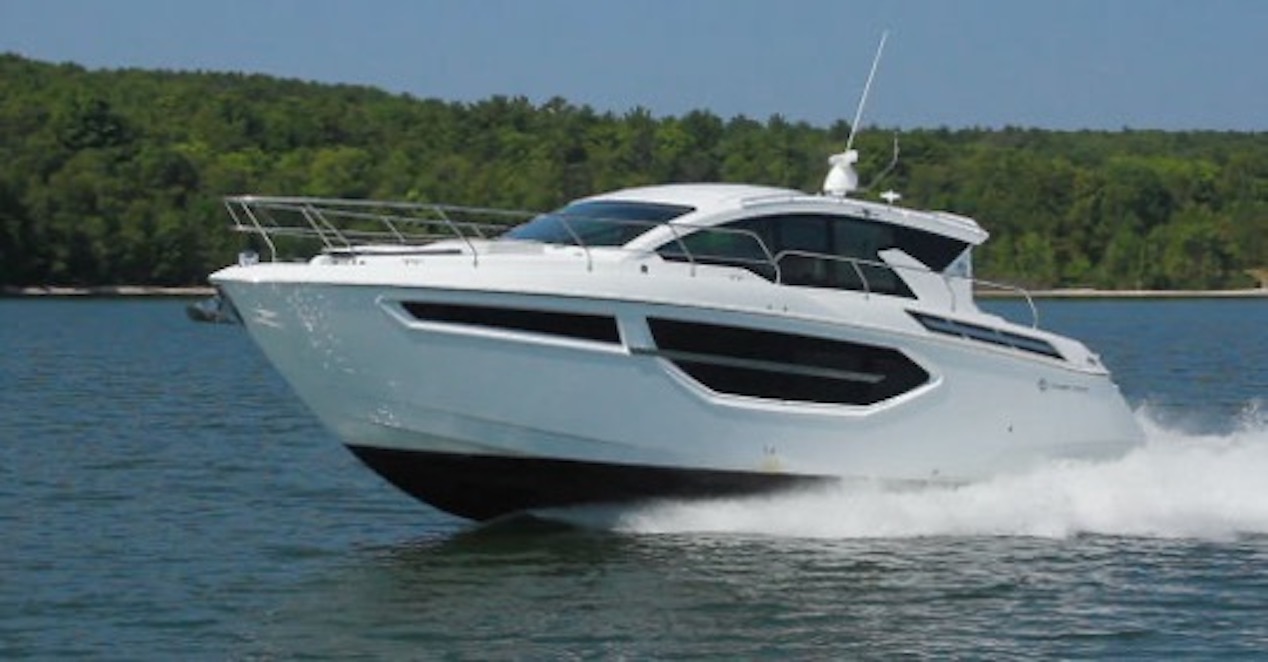
Mission
Cruisers Yachts designed the 42 Cantius to be a luxury sport cruiser with plenty of room for entertaining. The aft deck, salon, and helm are all on the same level separated by a large sliding stainless steel framed door that opens wide to create a seamless space. There’s an additional social zone in the bow and belowdecks she sleeps four. Power is twin Volvo Penta IPS pod drives.

Major Features
- Aft Grilling Center. The grill, sink, and other accessories are in an al fresco galley console on the transom. This is a smart location because it will keep passengers in the cockpit away from a hot grill.
- Single-Level Design. The cockpit and salon are on the same level separated by a stainless steel and glass door that creates the feeling of a unified space when the door is opened.
- Bow Sun Pads. The bow seating area has a pair of sun pads with backrests that tilt up to create chaise-style seating.
- Galley Aft on Salon Deck. This arrangement lends itself better to entertaining because the cook gets to be part of the fun while serving the salon and cockpit with ease.
Modern Techniques. Cruisers Yachts builds the 42 Cantius with resin infusion as opposed to traditional open molding. This results in more even resin saturation with less excess and better overall strength. A Vinylester barrier coat protects against water intrusion that can lead to osmotic blistering. The hull bottom, sides, and deck are cored, except in areas where thru-hull fittings are positioned. In those areas, the bottom is solid fiberglass. Stringers and bulkheads are configured to minimize unsupported areas and liners provide additional support and structural rigidity. The hull and deck attach in a shoebox-lid-style joint that is chemically sealed and mechanically fastened approximately every 3” (7.62 cm) with stainless steel hardware. All deck hardware, such as cleats and bowrail stanchions, are installed with aluminum backing plates.
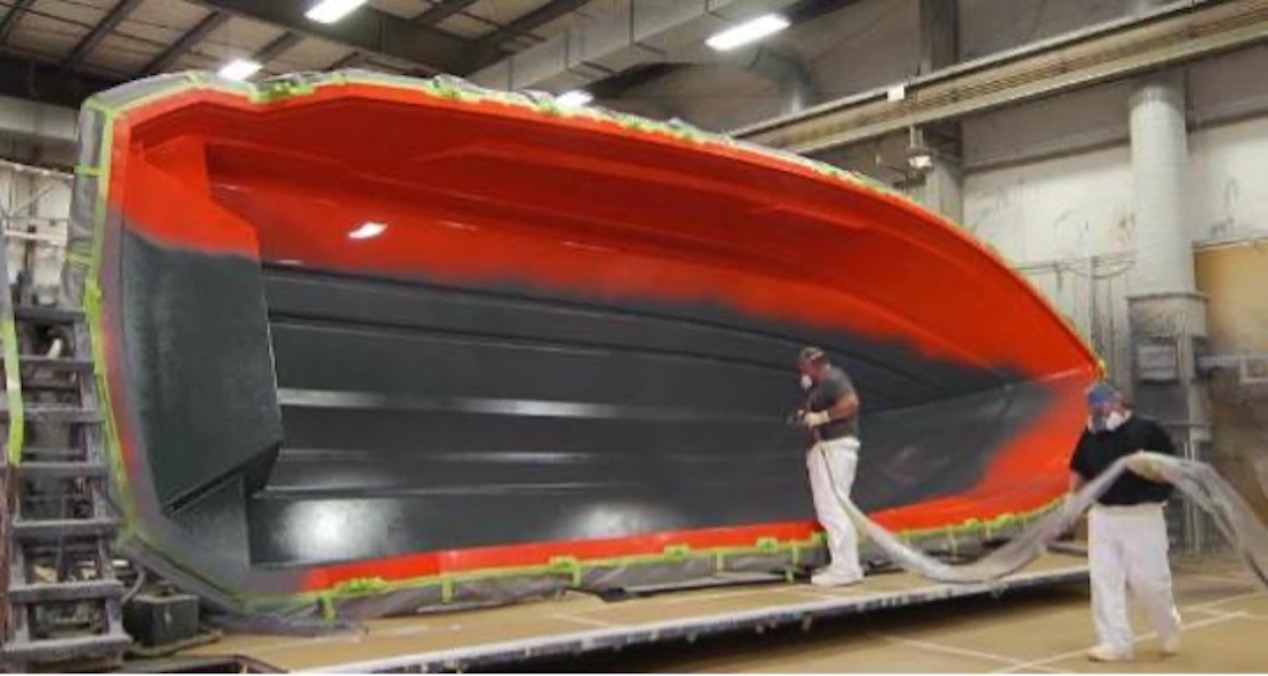

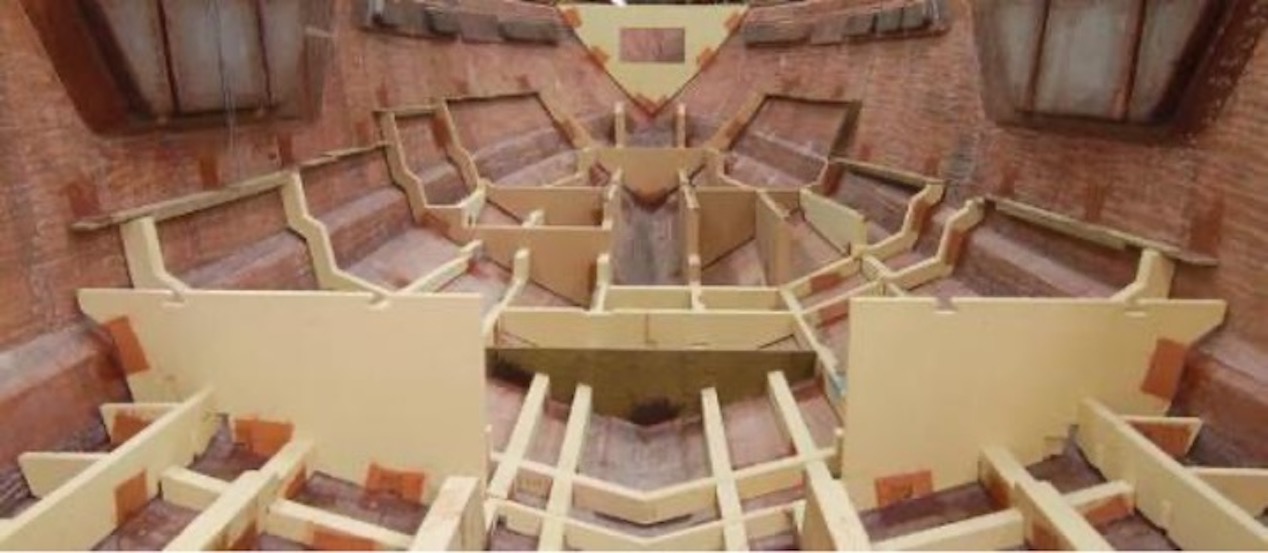
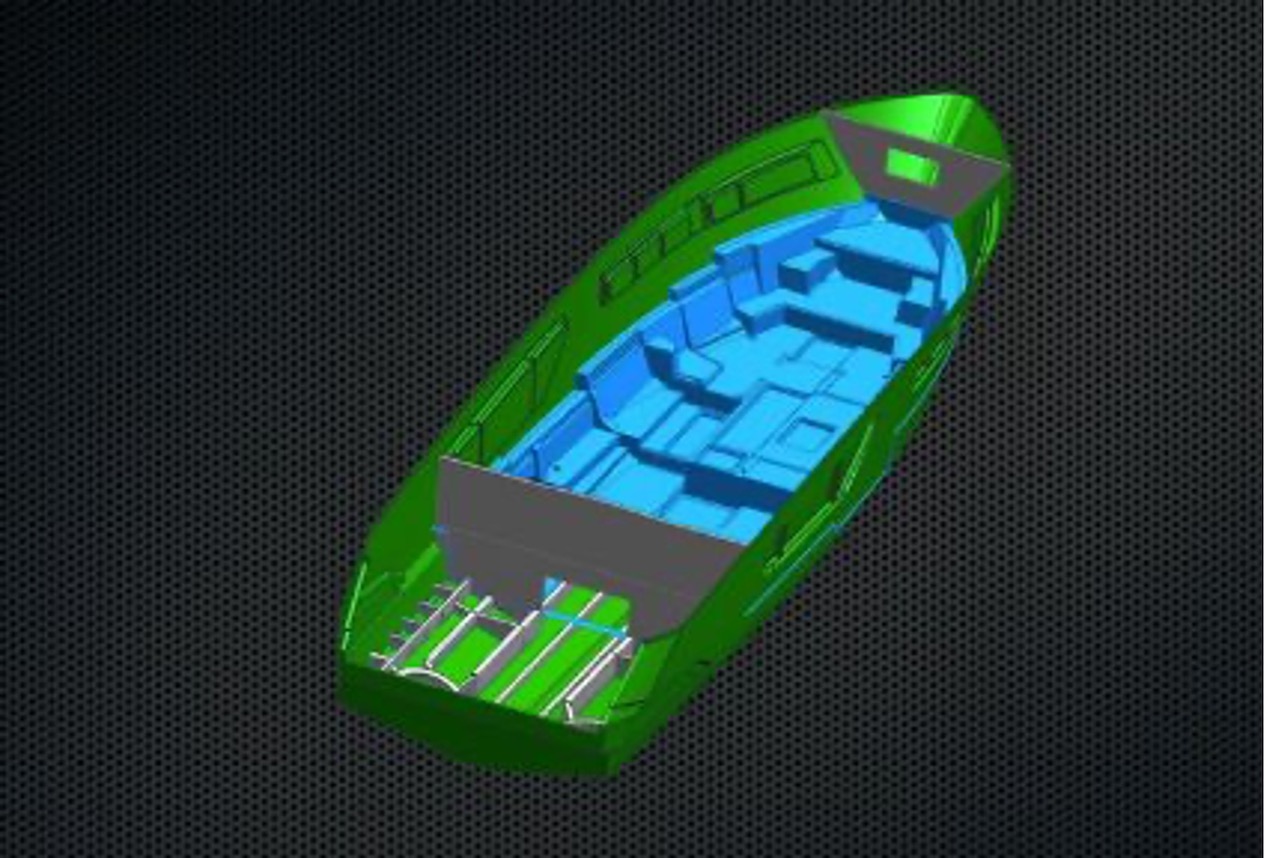
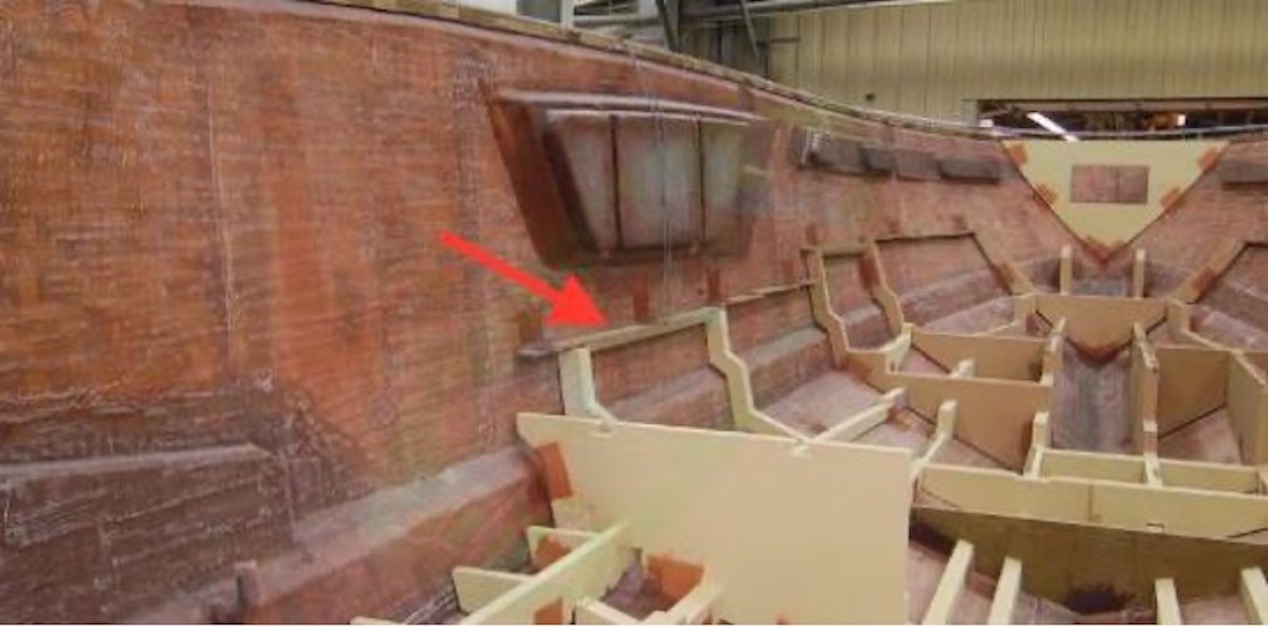
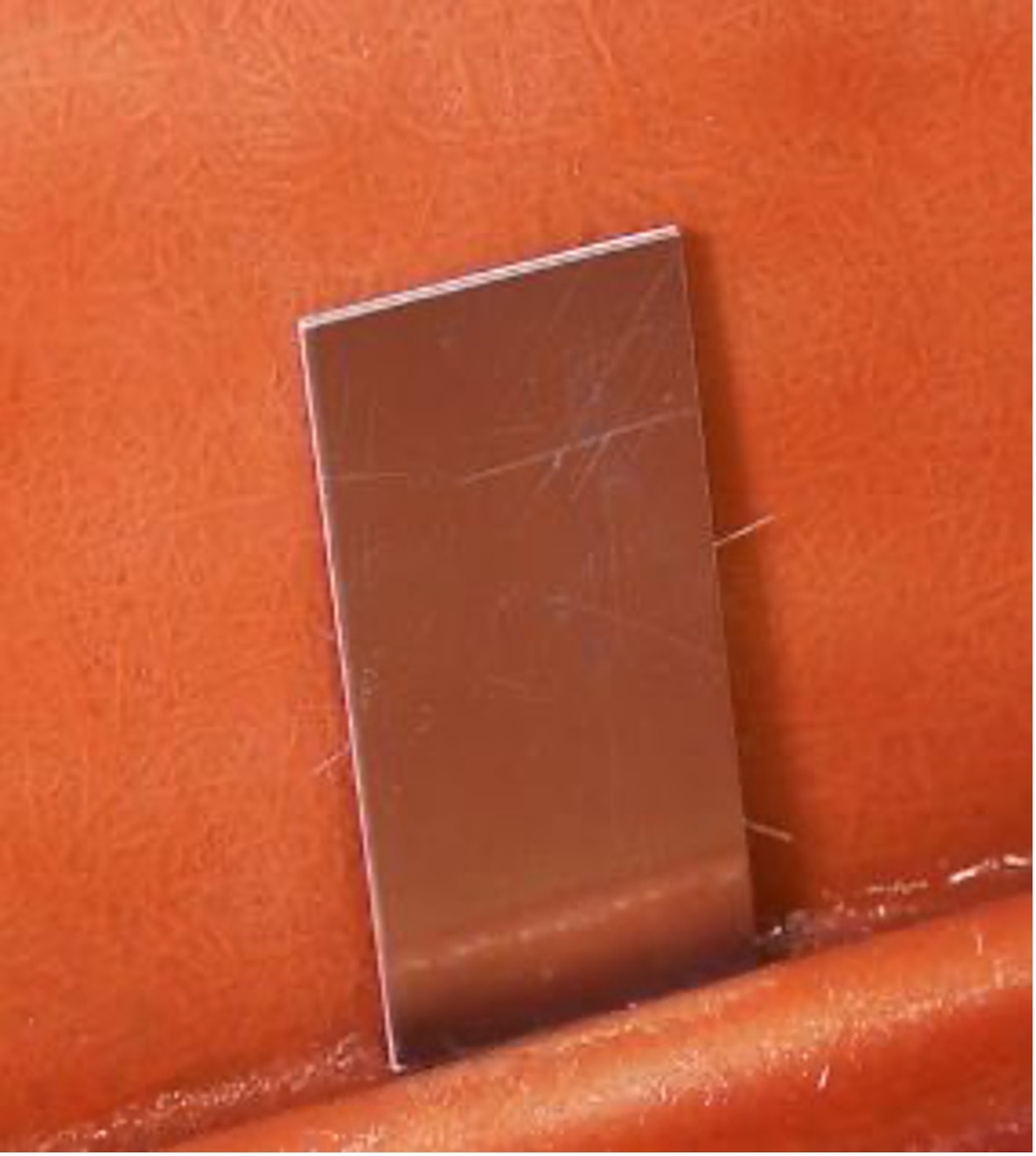
Rigging
Cruisers Yachts pays attention to the details when it comes to rigging and finishing the 42 Cantius. All limber holes are lined with a PVC pipe. Bilge pumps are mounted on aluminum bases, fuel tanks are installed on raised mounts for proper airflow beneath them, and the engine room is finished with 2” (5.08 cm) thick composite insulation. The company makes its own electrical panels, and wire harnesses are fabricated for each model. Wires are tinned copper strands, and each is individually labeled for its respective accessory with the label printed directly on the wire insulation, making the electrical system easier to service. Deutsch connectors are used to resist water penetration.
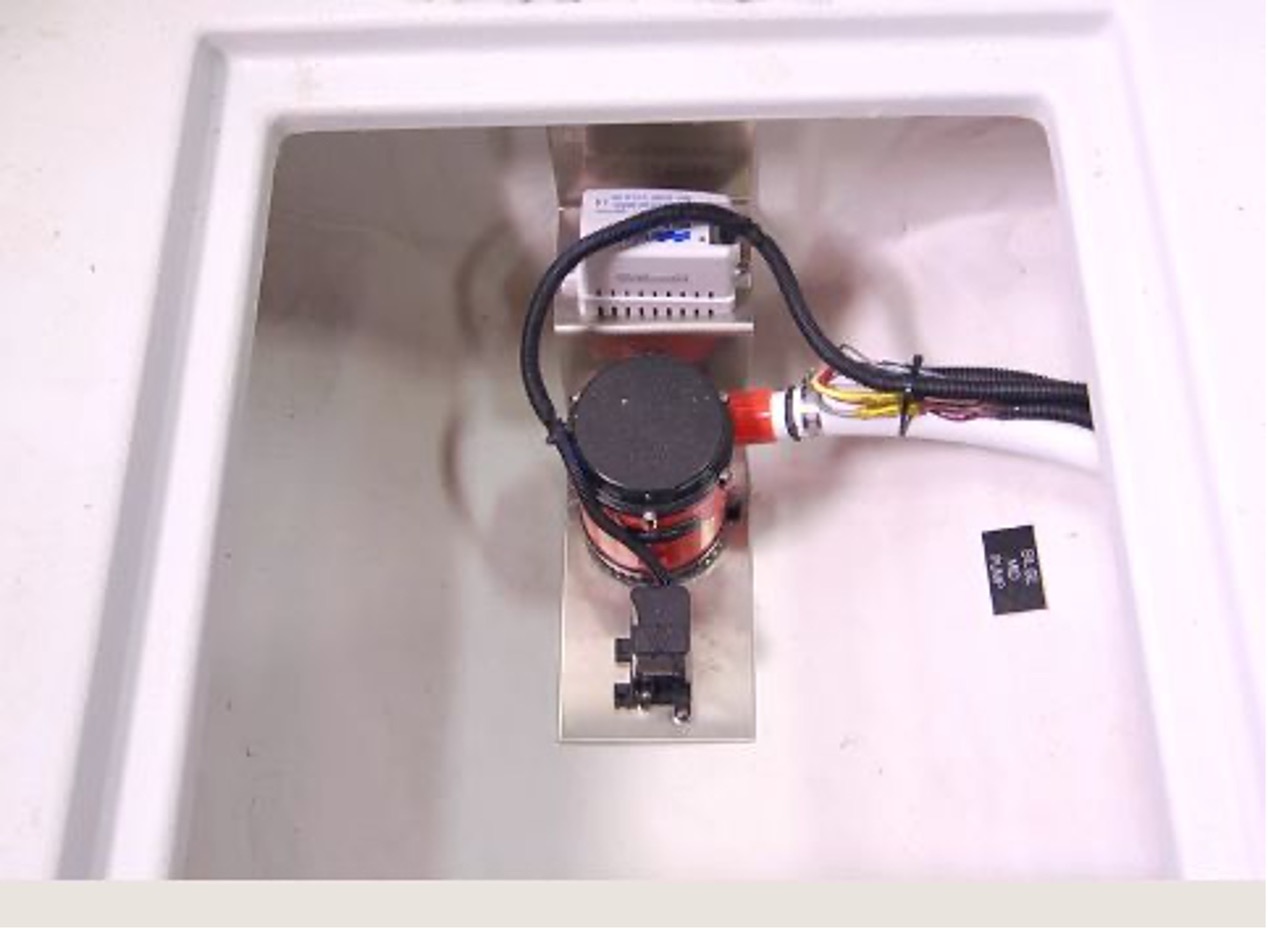
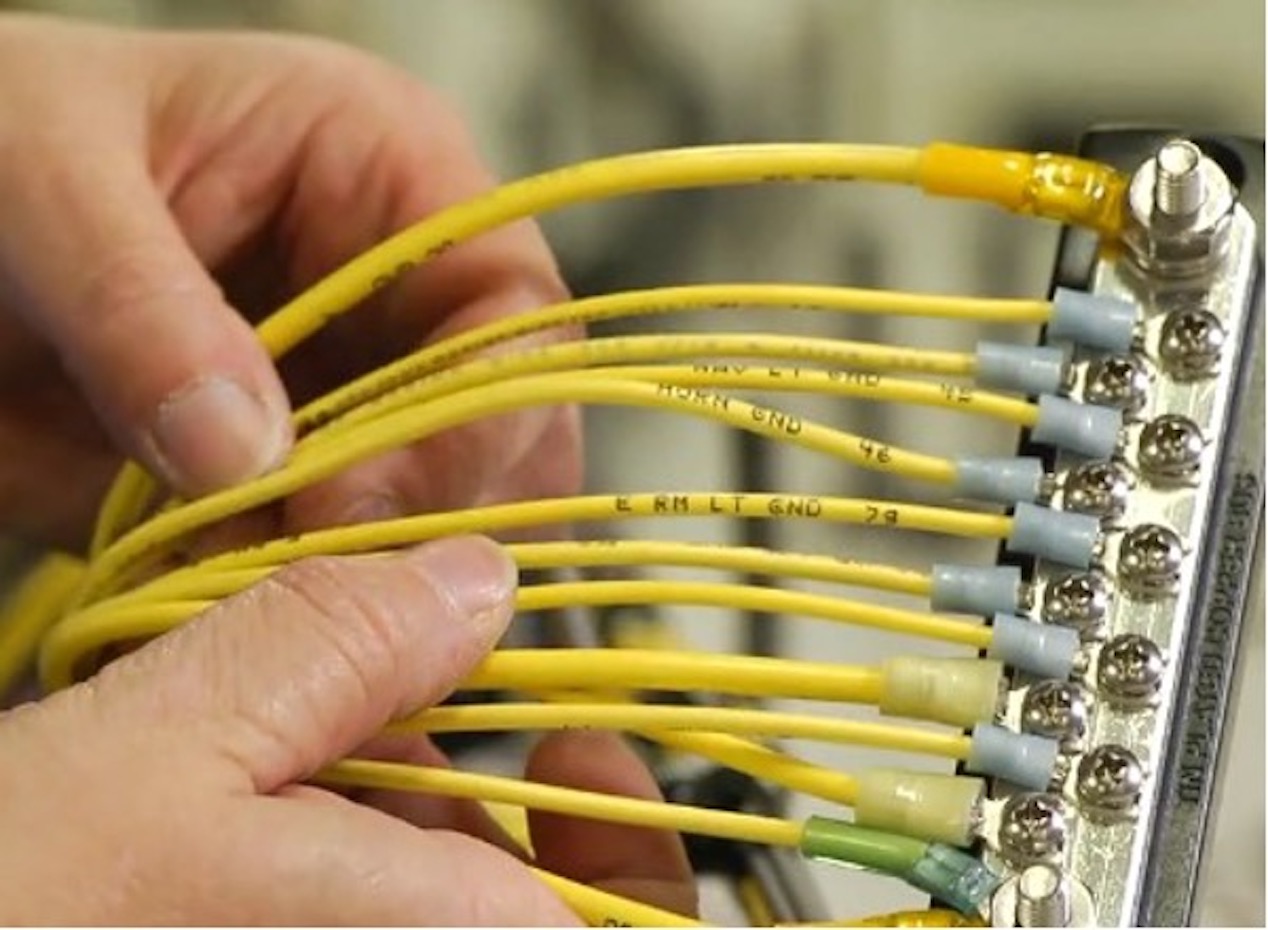
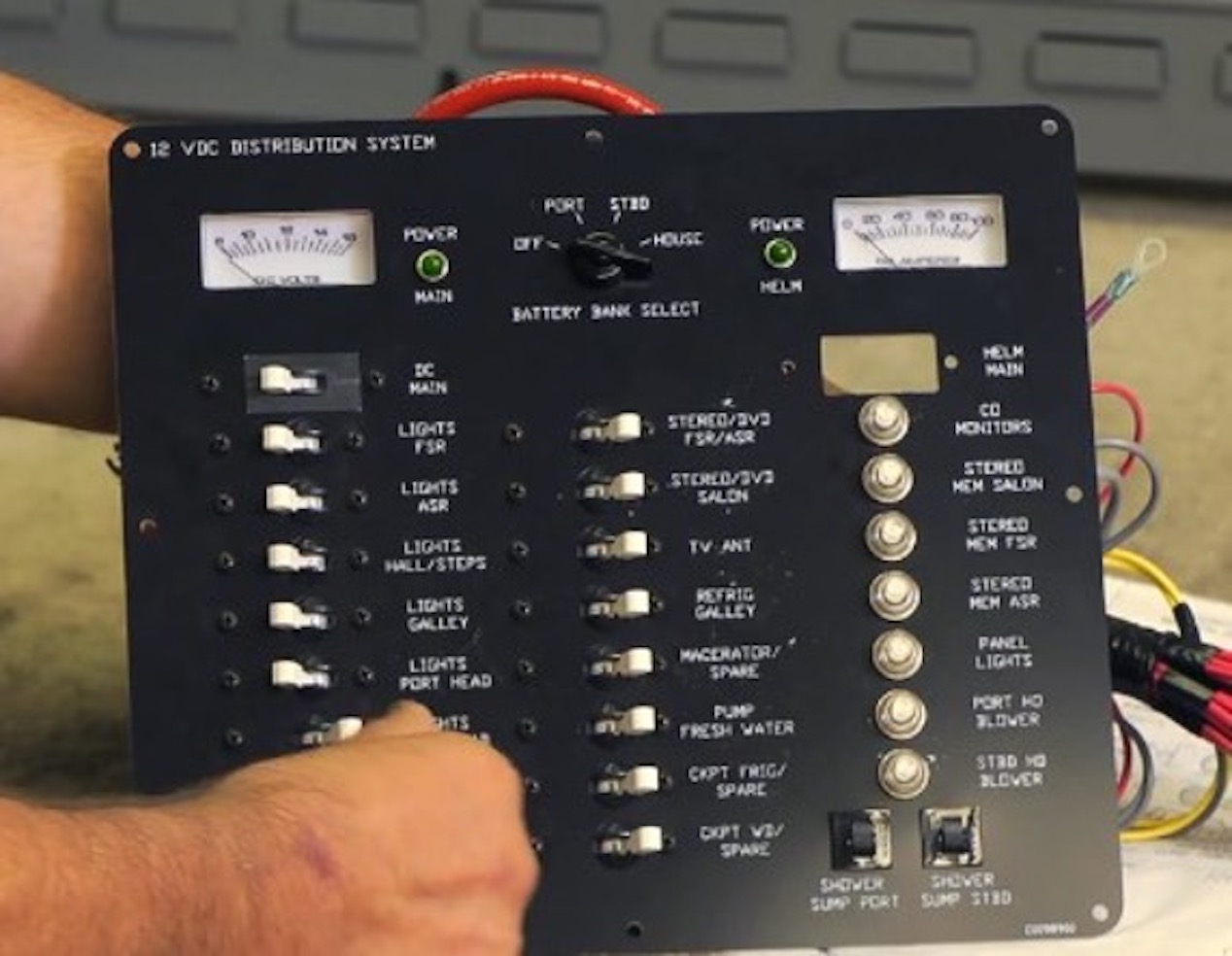
Performance
The Cruisers Yachts 42 Cantius has an LOA of 43’2” (13.15 m), a beam of 13’8” (4.16 m), and a draft of 40” (1.01 m). With an empty weight of 28,469 lbs. (12,913 kg), 36% fuel, and two people onboard, we had an estimated test weight of 29,537 lbs. (13,398 kg).
Powered by twin 370-hp Volvo Penta IPS500s turning 22P props, we reached a top speed of 29.5 knots at 3620 rpm. At that speed, we were burning 41 gph for a range of 194 nm.
Best cruise came in at 26.7 knots at 3400 rpm. At that speed, the fuel burn was reduced to 33.5 gph giving us a range of 214.8nm. All while still holding back a 10-percent reserve of the boat’s 300-gal (1,135.62 L). We reached time-to-plane in 6.7 seconds and accelerated to 20 mph in 9.4 seconds.
Handling
She's a stable and well-mannered boat and cruising is largely a hands-off affair. She turns with the characteristics of an IPS cruiser in that nothing happens fast thanks to the turning limits of the pods at speed. Bring the speed down and the turns can tighten up. We tested on a flat, calm day so the only comments we can make about waves are from the camera boats wake and they showed a smooth transition with no hull slap and a dry ride. Most of that dry ride had to do with the 6’4” (1.93m) freeboard aft and 6’9” (2.06m) forward.
Of course, where she really shines is at the dock, where her maneuverability in close confines can be best put to use. She responds well to the steering and is able to make tight turns quite well. She tracks solidly against the crosswind. When it comes time to actually dock the Cantius 42, a touch of a button activates the joystick, and we transitioned to docking mode. Then we can bring her in with exact detail. There's a great view and comfort level at that side window, and it keeps the pace relaxed and dialed in.
Boat Inspection
The Stern
The 42 Cantius has a water-level swim platform that comes out 4’ (1.52m) from the transom so it’s plenty deep to act as a private beach. A reboarding ladder is to the starboard side under a hatch. An electric-hydraulic platform is an option and it includes stairs to port that are deployed as the platform lowers into the water.
An optional grilling console is at the transom. It features a grill in the center flanked by storage with three covers opening on gas struts. Below is a refrigerated drawer. To the starboard transom there’s a single 50-amp shore power connection with a city water inlet right alongside. Cleats are mounted up high and out of the trip zone. A freshwater shower is just above.
The Cockpit
Ascend the three steps from the port side of the swim platform and into the cockpit of the 42 Cantius. It’s quite large measuring in at 6’8” x 8’2” (2.03m x 2.49m). There’s a lounge that wraps around in an L-shape to starboard and across the transom. Stowage for two carry-on coolers, or a life raft, is under the outboard bottom cushions. Storage under the aft seats joins with the storage at the grilling station at the platform. A small table fits into a pedestal for an al fresco lunch or post-cruise cocktails. A second table is optional.
Ahead and to port there’s a buffet serving area with counter space, beverage holders and a grab rail. Below is storage and an icemaker. All of this is under the protection of an optional extendable awning that comes out 5’ (1.52 m) from the trailing edge of the hardtop.
Moving Forward
While there are passageways and full rails on both sides of the boat, it’s easier to head to the bow on the port side; a deckhand or passenger would have to step over the cockpit-lounge backrest to use the starboard side or access it from the swim platform.
Side decks measure 16” (40.64 cm) wide on average. Rails are at a good height of 20” (50.80 cm) and we like the grab rails on the pilothouse.
The Bow
Fully forward the rails come up 29” (73.66 cm). Following a trend that we’re seeing more, Cruisers Yachts put some extra effort into the design and execution of the foredeck. There’s a U-shaped sun pad with 66” (137.64 cm) cushions that lay flat for group seating and sunning. The backrests can be raised into two separate positions to create dual forward-facing lounges. A wraparound bolster has integrated beverage holders to both sides. A 22” (55.88 cm) x 16” (40.64 cm) centerline table folds up and out from the center cushion on custom hinges to enhance the area’s versatility. There’s also an optional sunshade.
The recessed Quick windlass can also come equipped with an optional stainless-steel anchor on a thru-the-stem roller and an anchor washdown system. Foot control switches are to the side of the hatch.
The Salon
A three-section stainless steel framed sliding door opens to the port-hand side and a full 5’4” (1.62m) to blend the inside with the outside. It also keeps the seating areas exposed to each other for social settings. There’s an open feel even with the doors closed thanks to the 6’6” (1.98m) clearance to the upholstered overhead. Wood tones are Ebony, Mocha is another option, and both are available in high gloss or Matt finish.
The seating starts with an L-shaped Ultraleather upholstered dinette to starboard wrapping around a solid wood table on a fixed pedestal. This is all on an elevated platform 7.5” (19.05 cm) off the deck. As expected, there’s storage under the sofa cushions. Windows come down far enough to enjoy sightlines from the seated positions and opening windows are to both sides.
Aft to port is an L-shaped galley. With all the usual appliances such as a double burner cooktop, a single basin stainless-steel sink, refrigerator and microwave. A 28” (71.12 cm) TV is mounted to the upper cabinetry. The counters are Corian.
Forward to port is an elevated lounge with an aft-facing chaise section and two more sections for regular chair style seating.
Helm
To starboard, the helm has a 34” (86.36 cm) two-person bench seat. It includes a single flip bolster and dual flip armrests. The dash panel is finished in black Lexan and is fitted with two 12” (30.48 cm) multifunction displays, and an autopilot is in between them. A compass is below and in the center. A lower panel is carbon-fiber with electrical switches mounted to the starboard side. Controls are traditionally positioned to a starboard subpanel. Among them is a remote control for the forward displays, well back and within reach from the seated position.
Visibility is through a huge 9’4” x 3’11” (2.84m x 1.19m) single piece windshield. Another opening window is alongside the helm and allows access to a midship cleat… if one was positioned alongside. Overhead, an opening sunroof can let in fresh air.
Accommodations

Positioned just to port of the centerline and the helm station, the companionway leads belowdecks to the accommodations of the 42 Cantius. Each of the steps has a 10” (25.40 cm) riser. A large storage cabinet to the port side of the companionway is a good example of how there is no wasted space on the 42.
Master vs VIP
The 42 Cantius has a two-stateroom/two-head layout, but the jury is still out on which stateroom is the master. Even owners are split on which they use as a master.
Forward, the cabin has an island berth, 77” (195.58 cm) x 68” (172.72 cm), on the centerline and access to both sides via small steps. Headroom is 6’4” (1.93m) which leaves 3’6” (1.06m) over the berth. There’s an Ultraleather headboard. Natural light comes from two hullside windows and an overhead hatch. Storage is in lockers to both sides and in drawers under the berth. A 28” (71.12 cm) TV s bulkhead mounted. The head for these quarters is also the day head and includes a sink, Corian counters, an opening portlight, storage both above and below the vessel sink, and a walk-in shower. There’s also a separate entrance that allows this head to serve double duty as a day head.
In the midships stateroom, the 60” (152.4 cm) x 80” (203.2 cm) berth is positioned athwartships, with its head against the port hullside. The 5’ (1.52m) of headroom leaves 3’ (.91m) over the berth. There are hullside windows to both sides. There is an 82” (208.28 cm) sofa that adds a nice sitting component to this stateroom and a 28” (71.12 cm) TV is positioned just above. Hull side windows provide natural light to the stateroom. Nightstands and reading lights are to both sides of the berth.
Just ahead of the entrance is a set of cabinet doors leading to the vessel's main electrical panel. The head is to port and comprises a separate standup shower, sink, and MSD.
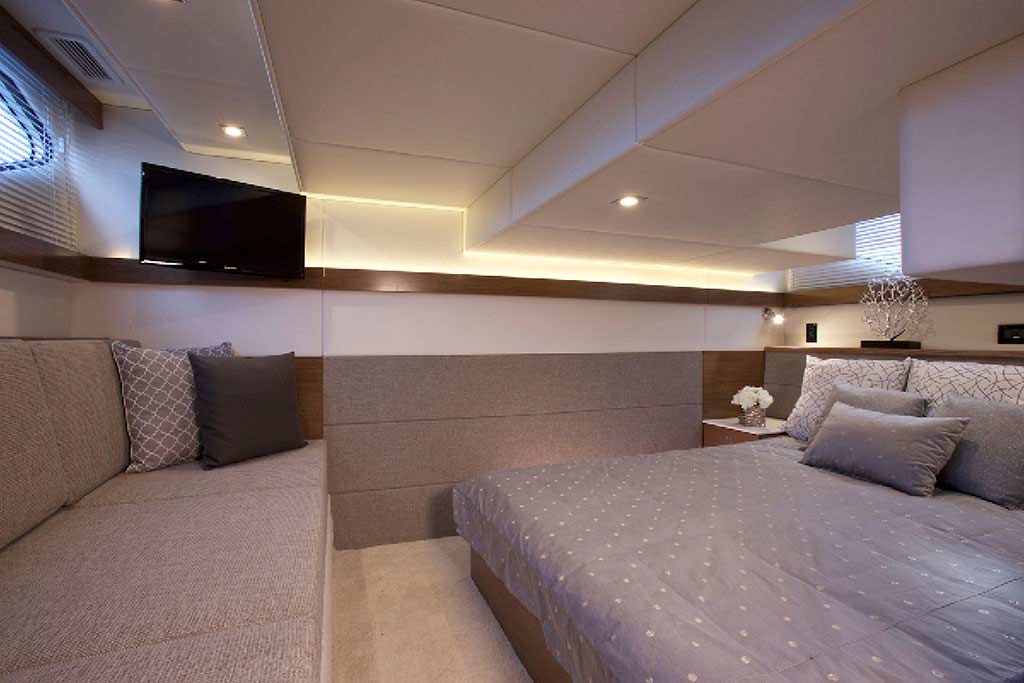
So, to sum up... forward stateroom — more headroom, easier access, more storage.
Aft Stateroom — Lounge included, private head, access to the main electrical panel.
Which is the master in your opinion?
Options to Consider
- Volvo Penta, D6, 500 IPS, DPS, EVC, 380HP
- Additional Cockpit Table w/ Black Cover
- Aft Deck Awning
- Anchor Washdown System
- Cockpit Ice Maker, Port, 120V
- Cockpit Seating, Gray
- Cockpit Washdown System
- Fresh Water
- Custom Sheets w/ Pillow Cases
- Generator, Diesel, 14KW, 120/240V
- Interior Wood, Ebony Oak
- Swim Platform w/ Hydraulic Lift
- Underwater Lighting
Observations
The 42 is the entry to the Cantius lineup that extends to the 60. While she may be the smallest she lacks for nothing as all the hallmarks of the current Cantius lineup, including the transom galley console, sleek exterior lines, and large hullside windows, are all present in this model.

